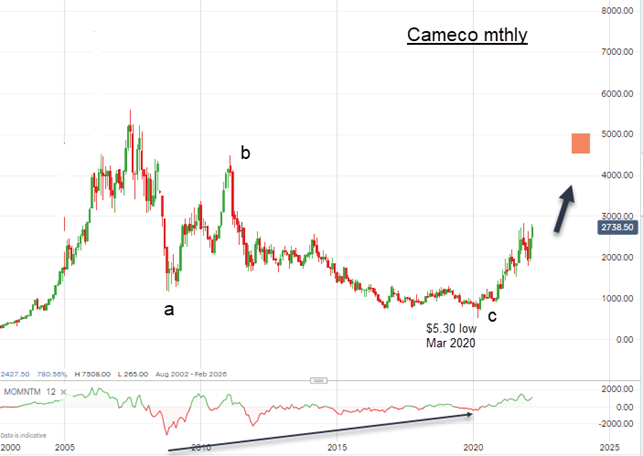Chart of the week: is this uranium share about to go nuclear?
21st March 2022 11:45
by John Burford from interactive investor
As oil prices boom, technical analyst John Burford believes there could be greater focus on nuclear power. This is favourite way to play the theme.

Finally, after energy markets have exploded and politicians can no longer ignore the obvious benefits of nuclear energy as a 'clean' domestic component to 'solving' the current energy crunch, momentum is clearly gathering for a switch to nuclear.
Memories of the very rare nuclear disasters are suddenly fading in light of the doubling of crude oil prices in two months as, once again, it is the markets that are driving the politics. Ideology dominates when all seems fair. But come a crisis, that is when political U-turns suddenly pop up.
Uranium oxide prices have been depressed for years as politicians have gone all-in on wind and solar with vast subsidies provided. In the UK, we are finding (to no-one's great surprise) that both are extremely unreliable as base load sources. Sometimes, the wind does not blow nor the sun shines. Hmm.
- Commodities shock: wild times as scarcity looms
- Energy independence: shares to benefit from green energy boom
- Renewable energy stocks: Atome Energy, Ceres Power & ITM Power
- Russia, Ukraine and the mining sector
The rather obvious alternative to fossil for base load is nuclear as the technology is very well developed, with Rolls-Royce Holdings (LSE:RR.) standing ready to supply their 'mini-nukes' in specialist situations.
In terms of security, Russia produces only around 12% of the global supply of uranium, with Australia dominating. But with vast deposits in Canada waiting to be exploited (when the ore price rises), the West appears to be self-sufficient in supplies.
That places Cameco Corp (NYSE:CCJ) – the largest Canadian miner – in an interesting light. Here is the long-term chart:

In the early 2000s, there was a flurry of activity, with the shares advancing as US crude oil spiked from sub-$20 to the famous high at $147 at the height of the financial crash in 2008.
But then crude began a lengthy decline and the case for nuclear went cold. The shares have been on a downtrend ever since as investor interest in uranium vanished from the radar.
Note that the decline has taken the form of an 'a-b-c' to the March 2020 Credit Crunch low of $5.30 – and on a very strong momentum divergence. Along with many other sectors, March 2020 saw major lows from which many shares have advanced.
- How to invest for difficult times
- Fundamentals: How to invest £100,000
- Nine things to watch for in the chancellor’s Spring Statement 2022
Remember, a ‘three down’ to a strong momentum divergence is often a setup for a strong reversal – particularly following a very lengthy decline (at least 10 years in this case).
And that is indeed what we are seeing, with the shares currently trading at the $27 region. I believe these shares are a buy. My first target is the old high at around $60.
These articles are provided for information purposes only. Occasionally, an opinion about whether to buy or sell a specific investment may be provided by third parties. The content is not intended to be a personal recommendation to buy or sell any financial instrument or product, or to adopt any investment strategy as it is not provided based on an assessment of your investing knowledge and experience, your financial situation or your investment objectives. The value of your investments, and the income derived from them, may go down as well as up. You may not get back all the money that you invest. The investments referred to in this article may not be suitable for all investors, and if in doubt, an investor should seek advice from a qualified investment adviser.
Full performance can be found on the company or index summary page on the interactive investor website. Simply click on the company's or index name highlighted in the article.
Disclosure
We use a combination of fundamental and technical analysis in forming our view as to the valuation and prospects of an investment. Where relevant we have set out those particular matters we think are important in the above article, but further detail can be found here.
Please note that our article on this investment should not be considered to be a regular publication.
Details of all recommendations issued by ii during the previous 12-month period can be found here.
ii adheres to a strict code of conduct. Contributors may hold shares or have other interests in companies included in these portfolios, which could create a conflict of interests. Contributors intending to write about any financial instruments in which they have an interest are required to disclose such interest to ii and in the article itself. ii will at all times consider whether such interest impairs the objectivity of the recommendation.
In addition, individuals involved in the production of investment articles are subject to a personal account dealing restriction, which prevents them from placing a transaction in the specified instrument(s) for a period before and for five working days after such publication. This is to avoid personal interests conflicting with the interests of the recipients of those investment articles.